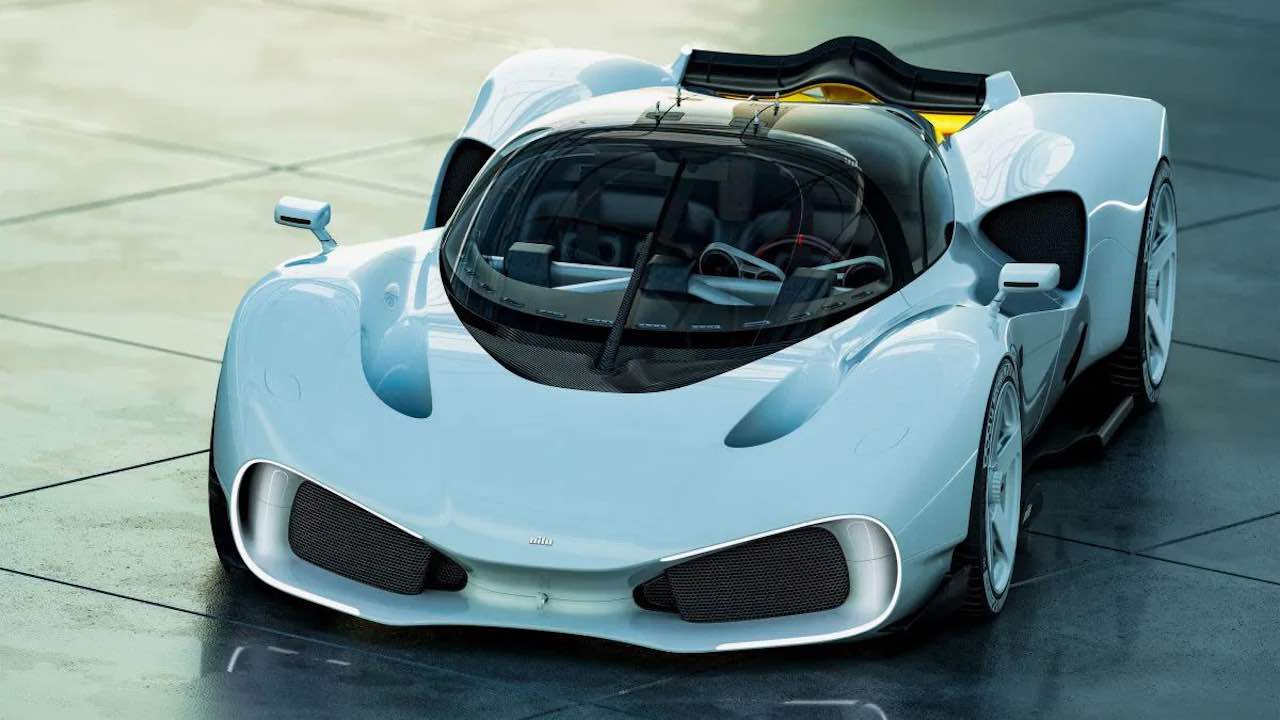It is not only the successor to the Huracán; it also represents a significant technological revolution. It was born around an unprecedented 3,995.2 cc V8 engine, developed in Sant’Agata Bolognese. Flat crankshaft, large-volume turbines, 10,000 rpm speed limiter, 200 hp/l. Thanks to three electric motors, maximum power reaches 920 hp; 343 km/h, and acceleration from 0 to 100 km/h in just 2.7 seconds. A perfect design because it is balanced, new frame, highly sophisticated aerodynamics
In Lamborghini it is known as Project 634 but its commercial name is Temerario, a bull that, thanks to its abundance, at the end of the 19th century, put the best bullfighters in the world in a difficult position. The Temerario is not just the successor to the Huracán; it is an innovative project, built around a new V8 engine, designed and developed in Sant’Agata Bolognese. An engine that will remain exclusive to Lamborghini for a long time, and will not be used, at least for the time being, in other Volkswagen Group cars. Therefore, the Temerario is technically freed from the rest of the German group and this was made possible thanks to the commercial successes achieved by Lamborghini (the Urus, in this sense, played a very important role), which ensured profitability, and invested in the development of a product from a technological point of view. Sophisticated but above all exclusive, a very important detail when talking about a car worth around 300,000 euros. In Italy, this will be roughly the price of the Temerario, which can be ordered from September and will be available in the second half of 2025.
10,000 RPM V8 Heat Engine
—
The Temerario is the second model in Lamborghini’s High Performance Electric Vehicle (HPEV) range after the Revuelto and completes the electrification of the Sant’Agata Bolognese range, following the market debut of the Urus SE. The new L411 engine (a 3,995.2 cc supercharged V8 that replaces the Huracán’s naturally aspirated V10) reaches a maximum power of 800 hp between 9,000 and 9,750 rpm and 730 Nm of torque between 4,000 and 7,000 rpm. The electric motor, positioned between the V8 engine and the gearbox, ensures immediate response even at low engine revs, providing additional torque to fill turbo lag and offering linear progression up to 10,000 rpm. There is Two massive turbochargerscentered in the V-shape formed by the banks at a 90° angle. Very high revs are also achieved by adopting a flat-plane crankshaft, with a 180° angle between the cranks. This type of crankshaft, generally used in racing engines, ensures optimal fluid dynamic behavior, allowing a uniform firing order between the banks and a more intense sound than classic American V8 engines. Another solution derived from the racing world concerns the finger grips coated with DLC (Diamond Like Carbon), a material that increases their hardness and therefore their resistance, making them suitable for speeds up to 11,000 rpm.
Three electric motors
—
The twin-turbo V8 works in synergy with three axial-flow (oil-cooled) electric motors, each with an output of 110 kW. The first, integrated into the crankshaft and positioned in front of the eight-speed dual-clutch gearbox, delivers 300 Nm of torque, which is used to start the V8 and integrate torque at low speeds. The other two motors are mounted on the front axle to ensure all-wheel drive when necessary or electric-only drive when the selected driving mode is selected and deliver up to 2,150 Nm to the wheels and a continuous power of 60 kW. In total, 920 hpand 343 km/h, and 2.7 seconds to accelerate from 0 to 100 km/h. The Temerario is equipped with a high-energy lithium-ion battery (4,500 Wh/kg) positioned in the central tunnel (where there is no drive shaft) to keep the car’s center of gravity as low as possible. The battery pack contains pouch cells with a total capacity of 3.8 kWhWhen the charge drops to zero, in just 30 minutes it is possible to fully recharge it using both regular domestic AC current and charging stations with up to 7 kW of power. The battery pack can also be recharged by regenerative braking of the front wheels or via the V8 engine. Thanks to the front e-axle and the rear electric motor, the pressure on the brakes during deceleration is reduced, while at the same time the battery is recharged.
Driving experience
—
Driving modes can be selected via the rotors on the steering wheel: the upper left one, marked with a red crown, allows you to choose between City, Road, Sport, Corsa and Turn Esc Off (Electronic controls are deactivated.) Furthermore, by pressing the square flag button for two seconds, launch control is activated to exploit the maximum potential when starting from a standing position. Along with the hybrid system, three new custom driving experiences (Recharge, Hybrid, Performance) also appear, which can be selected via the upper right rotor. The driving mode selection is displayed on the 12.3-inch digital instrument cluster (combined with an 8.4-inch central display and a 9.1-inch passenger display). The option appears for the first time on the Temerario Drift modeto help the driver control oversteer, focusing on driving enjoyment. Drift mode is operated via the lower rotor on the right side of the steering wheel, and is adjustable to three different levels: from Level 1, which facilitates oversteer while maintaining limited yaw angle, up to Level 3, which is for expert drivers to allow a wide yaw angle.
Design and diffraction
—
The Temerario’s lines remain angular but the stylistic balance achieved is exceptional, as there are no areas where the volumes are excessive. On an aerodynamic level, important targets have been achieved: +103% of rear load compared to the Huracán EVO, a value that rises to +158% in the Temerario version. I lightened upAn option that also adds a weight reduction of more than 25 kg, thanks to the carbon rims and the titanium exhaust. The underbody of the car plays a structural role in the context of aerodynamic efficiency. In fact, the underbody is equipped with vortex generators, three pairs of fins arranged like tree branches that increase the rear aerodynamic load, and assist in the function of the diffuser, which thanks to its surface area increased by 70% compared to the Huracán. Evo and an angle increased by 4 degrees increases the vertical extraction of air flow from below. Furthermore, to maximize the car’s high performance, a New concept of brake cooling To improve the car’s braking behaviour. At the front, a deflector mounted on the lower suspension arm takes the diverted flow from the front diffuser and directs it towards the front brake calipers, cooling them. Two other specific intakes are integrated into the bumper to channel a high flow of air from the bumper itself towards the disc centrifugal ducts; thus the “Y” duct has two inlets but one outlet, which sucks in high-pressure air, helping to improve the cooling of the braking system. The result is an overall improvement in cooling of 20% for the discs and 50% for the calipers compared to the Huracán EVO.
Cast aluminum frame
—
The supporting structure of the Temerario is the new Body-in-White. Made entirely of aluminium, the frame debuts a new high-strength alloy for high-pressure castings, the use of high-strength hydraulic extrusion and an increase in the number of hollow castings with closed inertia sections of thin thickness, obtained through the use of internal cores. These technologies have allowed Maximum reduction in construction complexity At the same time, a high level of integration of functions is linked to the installation of the hybrid powertrain: the number of structural components has actually been reduced by 50%, compared to an 80% reduction in welding with heat inputs. The new structure has enabled a 20% increase in torsional rigidity compared to the previous generation.
On the track without sacrificing comfort.
—
The interior has also been designed to emphasize the increased spaciousness of the passenger compartment. Headroom has increased by 34 mm compared to the Huracán, as well as legroom by 46 mm, to accommodate passengers up to 200 cm tall, also allowing them to wear a helmet. The increase in interior volume has also made it possible to ensure that More luggage storage spaceWhether in the front bonnet or behind the seats, both cabins can store two buggies each. Furthermore, the central cabinet provides space to store items such as smartphones, keys and wallets in the space created below the central screen. Lamborghini has also thought about who will use the Temerario on the track, by developing the Telemetry 2.0 app. During track driving sessions, the track and information on the lap time and each sector can be displayed on the dashboard display, as well as the reference time. Lamborghini Telemetry 2.0 includes 300 circuits (including variants) among the most important circuits in the world; compared to the previous version available on Huracan Sto More information is available, such as tire pressure or when and where the electrical component comes in. The user can also record videos of the experience via the cameras integrated into the Lavu system: immediately after the session, the telemetry data and videos can be displayed directly on the dashboard display or shared on the Unica app for a more in-depth analysis by combining the vehicle data with your heartbeat, thanks to the integration with Apple Watch.
Technical Data Sheet
Lamborghini Timerario
© All rights reserved

“Unable to type with boxing gloves on. Freelance organizer. Avid analyst. Friendly troublemaker. Bacon junkie.”










